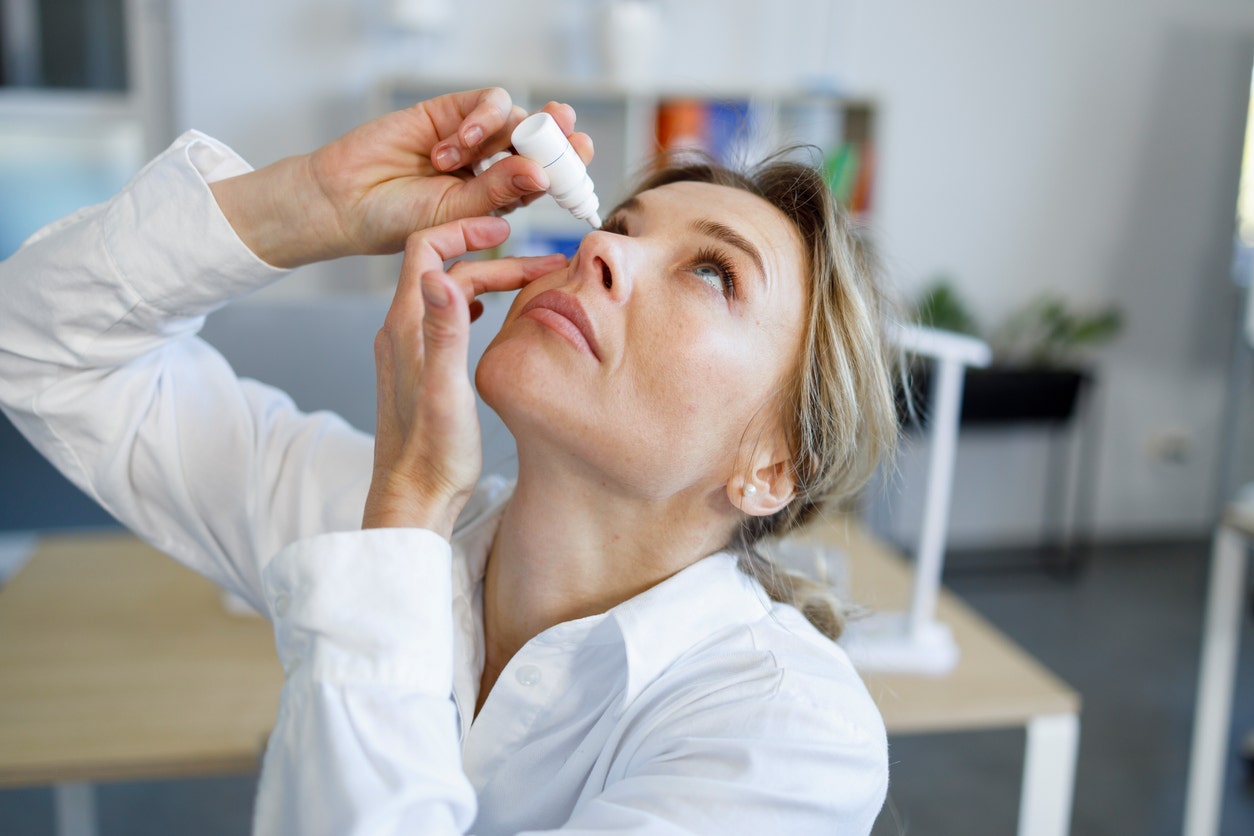Health
As eye drop recalls continue, here’s what you need to know to protect your vision

There have been a wave of eye drop recalls this year, with the U.S. Food and Drug Administration (FDA) recently announcing a nationwide voluntary recall of another 27 products.
On Oct. 27, the agency released a list of 26 products that consumers should not purchase and should stop using due to “the potential risk of eye infections that could result in partial vision loss or blindness.”
A few days later, the FDA added one more product to the list.
MORE EYE DROPS RECALLED AFTER FDA WARNING
The products are marketed under the following brands, the agency stated in its announcement:
- CVS Health
- Leader (Cardinal Health)
- Rugby (Cardinal Health)
- Rite Aid
- Target Up & Up
- Velocity Pharma
This year has seen a wave of eye drop recalls, with the FDA announcing a nationwide voluntary recall of 27 products in the country. (iStock)
“Ophthalmic drug products pose a potential heightened risk of harm to users because drugs applied to the eyes bypass some of the body’s natural defenses,” the FDA noted.
The agency called for the manufacturers to recall all lots of the specified products due to “unsanitary conditions in the manufacturing facility and positive bacterial test results from environmental sampling of critical drug production areas in the facility.”
Consumers should “properly discard” the products, the FDA recommended.
RITE AID CLOSING 154 STORES IN 15 STATES: HERE’S THE LIST
“The recent uptick in recalls has been linked to potential bacterial contamination due to unsanitary and inferior quality manufacturing facilities that did not meet the required FDA ‘good practices’ in manufacturing,” Dr. Ronald Benner, president of the American Optometric Association (AOA) in Missouri, told Fox News Digital.
“It’s important to note that eye drops are safe when manufactured and used properly.”

On Oct. 27, the agency released a list of 26 products that consumers should not purchase and should stop using due to “the potential risk of eye infections that could result in partial vision loss or blindness.” (iStock)
On Nov. 3, the FDA announced that Cardinal Health Inc. and Harvard Drug Group LLC had issued voluntary recalls for their products.
On Nov. 15, Kilitch Healthcare India Limited followed suit with its own voluntary recall.
CVS, Rite Aid and Target all said they would remove the products from their store shelves and websites, the FDA stated.
CVS PULLS POPULAR COLD MEDICINES FROM STORE SHELVES
“Patients who have signs or symptoms of an eye infection after using these products should talk to their health care provider or seek medical care immediately,” the FDA said in its announcement.
Thus far, there have been no reports of adverse events related to the October recall.

Signs of a potential eye infection symptoms may include redness of the eye or eyelid, eye pain or irritation, and watery eyes. (iStock)
Earlier in the year, however, the January 2023 recall of EzriCare or Delsam Pharma’s Artificial Tears resulted in 81 people reporting infections across 18 states, Benner noted.
“To date, 14 people have gone blind, four required enucleation and four others died,” he told Fox News Digital.
The FDA can only make recommendations and does not have the authority to issue mandatory recalls — that is left up to the individual retailers and manufacturers.
What consumers should do
Using contaminated artificial tears increases the risk of eye infections that could result in blindness or death, Benner warned.
“Patients who have used these products and/or have signs or symptoms of an eye infection should seek medical care immediately,” he said.
FAMILY DOLLAR RECALL OF OTC DRUGS, MEDICAL DEVICES SPANS 23 STATES
“Some eye infections can lead to further complications, especially if left untreated.”
Signs of a potential eye infection symptoms may include the following, he said.
- Redness of the eye or eyelid
- Eye pain or irritation
- Watery eyes
- Feeling of something in your eye (foreign body sensation)
- Increased sensitivity to light
- Blurry vision

Even if someone has not experienced any of these symptoms but has used any of the recalled products, Benner said they should see their optometrist for a comprehensive exam. (iStock)
Even if someone has not experienced any of these symptoms but has used one of the recalled products, Benner said that person should see their optometrist for a comprehensive exam to assess the front surface of their eye.
“If you have used [one of the] products or have experienced any new and/or prolonged irritation in your eyes, visit AOA.org to book an appointment with an AOA doctor of optometry near you,” he recommended.
CLICK HERE TO SIGN UP FOR OUR HEALTH NEWSLETTER
Anyone who owns the recalled eye drops should follow the FDA’s guidelines for throwing the products away, which may involve taking them to a drug take-back site, Benner noted.
The FDA also encourages health care professionals and patients to report adverse events or quality problems with any medicine to FDA’s MedWatch Adverse Event Reporting program.
Before consumers treat themselves with over-the-counter (OTC) eye drops, the AOA recommends consulting with their local optometrist and also checking the FDA’s website for an up-to-date list of products being recalled.

Anyone who owns the recalled eye drops should follow the FDA’s guidelines for throwing the products away, which may involve taking them to a drug take-back site. (iStock)
“When talking with your optometrist, it’s important to share any prescribed and over-the-counter medications currently in use and ask for their professional opinion,” Benner told Fox News Digital. “This can also help ensure that an appropriate treatment plan is in place.”
Fox News Digital reached out to all involved companies and to the FDA for additional comment.
CVS Health provided the following statement to Fox News Digital regarding the product recalls: “Upon receiving notification by the FDA, we immediately stopped the sale in-store and online of all products supplied by Velocity Pharma within the CVS Health Brand Eye Products portfolio.”
“Customers who purchased these products can return them to CVS Pharmacy for a full refund. We’re committed to ensuring the products we offer are safe, work as intended and satisfy customers, and are fully cooperating with the FDA on this matter.”
For more Health articles, visit www.foxnews.com/health.

Health
Nutritionists react to the red food dye ban: 'Took far too long'

The U.S. Food and Drug Administration (FDA) announced a ban this week on red dye No. 3, or erythrosine, from foods and oral medications due to a potential cancer risk.
Food manufacturers have until Jan. 2027 to remove the dye (Red 3) from their products, and drug manufacturers have until Jan. 2028, the Associated Press reported.
The dye was removed from cosmetics nearly 35 years ago for the same cancer-related concerns.
FDA BANS RED FOOD DYE DUE TO POTENTIAL CANCER RISK
Following the Wednesday announcement of the new ban, nutritionists and other health experts applauded the removal of the additives from America’s food supply.
Los Angeles-based registered dietitian nutritionist Ilana Muhlstein shared excitement about the FDA “finally” banning the synthetic dye that has been in candy, cereals and strawberry-flavored drinks for “far too long.”
Red 3 can be found in a variety of food products, most commonly candies and colorful sweets. (iStock)
“What is wild is that this decision comes over three decades after the same dye was banned in cosmetics like lipstick because there was enough evidence linking it to cancer in animals,” she told Fox News Digital.
CALIFORNIA PROPOSES BILL TO BAN SOME FOOD PRODUCTS WHILE NUTRITIONISTS FRET ABOUT ‘GROSS’ INGREDIENTS
“For years, consumer advocacy groups and researchers have pushed for this change, citing not only cancer risks but also potential links to hyperactivity and ADHD in kids.”
Certified holistic nutritionist and The Power of Food Education founder Robin DeCicco, based in New York, commented that “it’s about time” Red 3 was banned.

A certified holistic nutritionist (not pictured) warned that red dye No. 3 appears in some products that “you’d never expect.” (iStock)
“It never made sense to me why the dye was taken out of lipsticks and blushes 30 years ago but has been allowed to be in our food supply,” she reiterated to Fox News Digital. “There has been evidence of the dye causing cancer in rats for decades.”
“Our kids deserved better, and it’s frustrating that it took this long for action to be taken.”
While the ban is an “obvious win for public health,” she still feels “frustrated” that it took so long, she said.
“The FDA became aware of the risks in the 1980s, and other countries, like those in the EU, banned red dye No. 3 years ago,” she noted. “Yet big food manufacturers lobbied hard to delay this decision because these artificial dyes are cheap, convenient and profitable.”

Red dye No. 3 is often used in strawberry flavoring, according to experts. (iStock)
The dye was commonly used in products that are primarily marketed to children, she noted, such as colorful lollipops, candies and breakfast cereals.
“Our kids deserved better, and it’s frustrating that it took this long for action to be taken,” Muhlstein added.
‘Stay informed’
The ban is a “step forward,” but Muhlstein said it’s also a reminder to “stay informed about what we’re feeding our families.”
Red dye No. 3 is included in other products that aren’t so obvious, including some pre-packaged vegan meats, fruit cups, mini muffin snacks, mashed potatoes, yellow rice and sugar-free water flavors, according to experts.
CLICK HERE TO SIGN UP FOR OUR HEALTH NEWSLETTER
DeCicco encouraged consumers to always read the ingredient label and to look for natural replacements for these products.

The dye was commonly used in products that are primarily marketed to children, such as colorful lollipops, candies and breakfast cereals. (iStock)
“It’s not about deprivation or restriction – I always say it’s about eating foods with high-quality ingredients,” she said. “The ingredients matter more than anything else, and they’re out there.”
For more Health articles, visit www.foxnews.com/health
“I have worked with many families with kids who have ADHD, and removing sugar and artificial food dyes and additives can in some cases lessen symptoms (as one part of treatment),” DeCicco added.
Colorful food without carcinogens
While nutritionists recommend that consumers stay away from foods that contain red dye or erythrosine on the label, there are healthier, natural alternatives to keep food fun.

Using alternatives for red dye like pomegranate juice or fruit powder can keep food fun, according to nutritionists. (iStock)
Muhlstein recommended adding 1 to 2 tablespoons of pomegranate juice to a baking recipe, such as vanilla cake, to give the batter a natural red hue.
She also suggested mixing crushed-up, freeze-dried strawberries into white frosting or whipped cream.
“Beetroot powder, hibiscus powder and even mashed raspberries are great alternatives, too,” she added.
Fox News Digital’s Melissa Rudy contributed reporting.
Health
Mom’s Gripes About Sister-in-Law Put Daughter in a Bind

My mother is hypercritical of my brother’s wife, to the point that she blames my sister-in-law for my brother’s “failings” (not getting a better job, not taking better care of his health, etc.). It has gotten worse now that there are grandchildren. My mother constantly criticizes how my sister-in-law is raising the kids, who are lovely and adore their grandparents.
Although my mother will occasionally raise criticisms with my sister-in-law and brother, I am mostly her audience.
I have a great relationship with my sister-in-law, and when my mother goes off on one of her rants, I defend her. I tell my mother how lucky she is to have such wonderful grandchildren, and point out that my brother is an adult who makes his own decisions. This just leads to an argument between my mother and me.
When I finally told my mother how much it hurts me to hear her say these things about my sister-in-law, she said that she needed to air her frustrations with someone. I want to be there for my mother, but I don’t like being put in this position. How do I navigate this?
From the Therapist: The short answer to your question is that you can navigate this by no longer engaging in these conversations. But I imagine you already know this. What you might be less aware of is that you aren’t being “put in this position” of supportive daughter, protective sister-in-law and unwilling confidante. You’ve chosen it, and it’s worth examining why you’ve signed up for a job you don’t want — and what makes it hard to resign.
Usually when we find ourselves repeatedly engaging in uncomfortable family patterns, it’s because they echo familiar roles from our childhood. It sounds as if you’re struggling with enmeshment, a relationship pattern in which boundaries between family members become blurred or are nonexistent.
Think of enmeshment as being like two trees that have grown so close together that their branches have become intertwined. While this might look like closeness, it actually prevents either tree from growing in a healthy way. In your case, your mother’s emotions and grievances have become so entangled with your own emotional life that it’s hard to distinguish where her feelings end and yours begin.
You mention wanting to “be there” for your mom even though these conversations hurt you. Many adult children who struggle to say no to their parents grew up serving as their parents’ emotional support system, or absorbing their parents’ feelings, even at the expense of their own. When you told your mother how much her venting hurt you, she responded not by acknowledging your feelings, but by asserting her need to “air her frustrations.” Her response reveals something important: She sees you as a vessel for her emotional overflow rather than as someone with valid feelings of your own. And yet, despite your hurt, you’re still more concerned about her feelings than yours.
You’re asking how to navigate this situation, but I think the deeper question is: How can you begin to value your own emotional needs?
You can start by reframing what it means to make a reasonable request, which is essentially what setting a boundary is. A boundary isn’t about pushing someone away. Instead, it’s about making a bid for connection. It’s saying: “I want to feel good being close to you, but when you do X, it makes me want to avoid you. Help me come closer.”
Establishing a boundary consists of three steps:
-
State the issue and the desire to come closer (what will make this possible): “Mom, I love you and want to support you, but these conversations about my sister-in-law put me in an impossible position and make me want to avoid talking with you, which I know isn’t what either of us wants. I’m happy to talk about other things together, but in order to keep our relationship strong, I need this topic to be off limits.”
-
Set the boundary (what you will do): “If you’re struggling with their choices, I’m happy to support you in finding a therapist who can help you work through these feelings. But if you bring up these frustrations with me, I’m going to end the conversation and we can talk another time about other things.”
-
Hold the boundary (do what you say): A boundary isn’t about what the other person will or won’t do. A boundary is a contract with yourself. If you say you’ll end the conversation when your mom brings up your sister-in-law, you need to hold that boundary every single time. If you end the conversation only 90 percent of the time, then why would the other person honor your request when 10 percent of the time, you can’t honor it yourself? Honoring your request might sound like: “Mom, I’m going to end the conversation now because I’m not comfortable talking about my sister-in-law. I love you, and we’ll talk later.”
If you start to feel guilty, remember that just because someone sends you guilt doesn’t mean you have to accept delivery. Remind yourself that when you become your mother’s outlet for criticism of your sister-in-law, you’re participating in a cycle that strains loyalties and causes you personal distress. And keep in mind that being a good daughter means setting boundaries that encourage our parents to grow, rather than enabling patterns that harm our family relationships.
Want to Ask the Therapist? If you have a question, email askthetherapist@nytimes.com. By submitting a query, you agree to our reader submission terms. This column is not a substitute for professional medical advice.
Health
Cancer death rates decline yet new diagnoses spike for some groups, says report

Alcohol linked to 7 types of cancer
Dr. Nicole Saphier joins ‘America’s Newsroom’ to discuss the surgeon general pushing for cancer warning labels on alcohol and the CDC warning of norovirus cases surging in parts of the U.S.
A major annual cancer report has revealed a mix of good news and points of concern.
Cancer diagnoses are expected to exceed two million in 2025, with approximately 618,120 deaths predicted, according to the American Cancer Society’s annual cancer trends report, which was published today in CA: A Cancer Journal for Clinicians.
ACS researchers compiled data from central cancer registries and from the National Center for Health Statistics.
ALCOHOL LINKED TO CANCER RISK IN US SURGEON GENERAL’S NEW ADVISORY
While mortality rates have declined, certain groups are seeing a spike in diagnoses, the report noted.
Cancer diagnoses are expected to exceed two million in 2025, with approximately 618,120 deaths predicted. (iStock)
“Continued reductions in cancer mortality because of drops in smoking, better treatment and earlier detection is certainly great news,” said lead author Rebecca Siegel, senior scientific director of surveillance research at the ACS in Georgia, in a press release.
“However, this progress is tempered by rising incidences in young and middle-aged women, who are often the family caregivers, and a shifting cancer burden from men to women, harkening back to the early 1900s, when cancer was more common in women.”
Overall decline in death rates
Cancer death rates dropped 34% between 1991 and 2022, according to the ACS report.
That equates to approximately 4.5 million deaths avoided due to early detection, reductions in smoking, and improvements in treatment, the report stated.
Cancer death rates dropped 34% between 1991 and 2022.
Several factors likely contributed to this decline, noted John D. Carpten, Ph.D., chief scientific officer at City of Hope, a national cancer research and treatment organization in California.
“I think a big one is smoking cessation and the battle against lung cancer, which has always been the most common form of cancer and is tied to tobacco use,” Carpten told Fox News Digital in an on-camera interview.

“Screening programs are a critical component of early detection, and expanding access to these services will save countless lives.” (iStock)
“But without a doubt, I think new and better methods for early detection, and screening for colorectal cancer and other forms of the disease, have also allowed us to see a decrease.”
Lifestyle improvements have also helped to decrease mortality, he said, along with the development of new and better therapies for cancer.
LIVER CANCER PATIENT GIVEN 6 MONTHS TO LIVE LOSES 76 POUNDS EATING SPECIFIC FOODS
Despite overall declines in mortality, the report revealed that death rates are rising for cancers of the oral cavity, pancreas, uterine corpus and liver (for females).
Some common cancers have also seen an increase in diagnoses, including breast (female), prostate, pancreatic, uterine corpus, melanoma (female), liver (female) and oral cancers associated with the human papillomavirus, the report stated.
Increased diagnoses among certain groups
Diagnoses for many cancer types are increasing among certain groups.
Cancer rates for women 50 to 64 years of age have surpassed those for men, the report revealed. For women under 50, rates are 82% higher than males in that age group.

The report revealed that diagnoses of colorectal cancer in men and women under 65 and cervical cancer in women between 30 and 44 years of age has increased. (iStock)
As far as what is influencing the “disconcerting trend” in women’s cancers, Carpten said it is likely “highly nuanced” and will require additional research.
“The decrease in fertility and increases in obesity that we’ve seen are risk factors for breast cancer, especially in postmenopausal middle-aged women,” he said.
“But there could be other modifiable risk factors at play, like alcohol and physical activity.”
Cancer rates for women 50 to 64 years of age have surpassed those for men.
Another trend in the increase in early cancers is occurring in individuals under the age of 50, Carpten noted.
In particular, the report revealed that diagnoses of colorectal cancer in men and women under 65 and cervical cancer in women between 30 and 44 years of age has increased.

Some common cancers have also seen an increase in diagnoses, including breast (female), prostate, pancreatic, uterine corpus, melanoma (female), liver (female) and oral cancers associated with the human papillomavirus. (iStock)
The report also discusses inequities in cancer rates among certain ethnic groups, with Native American and Black people experiencing higher diagnoses of some cancer types.
“Progress against cancer continues to be hampered by striking, wide static disparities for many racial and ethnic groups,” said senior author Dr. Ahmedin Jemal, senior vice president of surveillance and health equity science at the ACS, in the release.
AI DETECTS OVARIAN CANCER BETTER THAN HUMAN EXPERTS IN NEW STUDY
The report shows mixed trends for children, with diagnoses declining in recent years for patients 14 years of age and younger, but rising for adolescents between 15 and 19.
“Mortality rates have dropped by 70% in children and by 63% in adolescents since 1970, largely because of improved treatment for leukemia,” the ACS stated in the release.
Pancreatic cancer a growing concern
The ACS report also warns about “lagging progress” against pancreatic cancer, the third-leading cause of cancer death in the U.S.

The ACS report also warns about “lagging progress” against pancreatic cancer, the third-leading cause of cancer death in the U.S. (iStock)
Rates of diagnoses and deaths from the disease type are on the rise.
“Pancreatic is an incredibly deadly form of cancer,” Carpten said.
One of the main issues with pancreatic cancer, he said, is that it sometimes can grow in an individual for up to 10 years before it’s detected.
“If we can identify those cancers when they’re at at a curable stage, we can improve outcomes.”
One of the best opportunities for beating pancreatic cancer is early detection, Carpten said.
“By the time those cancers have advanced, they’ve spread to the liver or other organs, and they’re almost impossible to cure at that stage,” he said.
“If we can identify those cancers when they’re at a curable stage, we can improve outcomes.”
‘It takes a village’
Making progress in fighting cancer “takes a village,” Carpten told Fox News Digital.
“It will require partnerships between the community, the health care system, cancer researchers, government, industry — we all have to work together if we want to continue to see a decrease and an ultimate increase in cures,” he said.

“We all have to work together if we want to continue to see a decrease and an ultimate increase in cures,” a cancer researcher said. (iStock)
Dr. Wayne A. I. Frederick, interim chief executive officer of the American Cancer Society and the American Cancer Society Cancer Action Network (ACS CAN), stated that the report highlights the need to “increase investment in both cancer treatment and care, including equitable screening programs.”
CLICK HERE TO SIGN UP FOR OUR HEALTH NEWSLETTER
“Screening programs are a critical component of early detection, and expanding access to these services will save countless lives,” he said in the release.
For more Health articles, visit www.foxnews.com/health
“We also must address these shifts in cancer incidence, mainly among women. A concerted effort between health care providers, policymakers and communities needs to be prioritized to assess where and why mortality rates are rising.”
Fox News Digital reached out to the ACS for further comment.
-
/cdn.vox-cdn.com/uploads/chorus_asset/file/25822586/STK169_ZUCKERBERG_MAGA_STKS491_CVIRGINIA_A.jpg)
/cdn.vox-cdn.com/uploads/chorus_asset/file/25822586/STK169_ZUCKERBERG_MAGA_STKS491_CVIRGINIA_A.jpg) Technology1 week ago
Technology1 week agoMeta is highlighting a splintering global approach to online speech
-

 Science5 days ago
Science5 days agoMetro will offer free rides in L.A. through Sunday due to fires
-
/cdn.vox-cdn.com/uploads/chorus_asset/file/25821992/videoframe_720397.png)
/cdn.vox-cdn.com/uploads/chorus_asset/file/25821992/videoframe_720397.png) Technology1 week ago
Technology1 week agoLas Vegas police release ChatGPT logs from the suspect in the Cybertruck explosion
-

 Movie Reviews1 week ago
Movie Reviews1 week ago‘How to Make Millions Before Grandma Dies’ Review: Thai Oscar Entry Is a Disarmingly Sentimental Tear-Jerker
-

 Health1 week ago
Health1 week agoMichael J. Fox honored with Presidential Medal of Freedom for Parkinson’s research efforts
-

 Movie Reviews1 week ago
Movie Reviews1 week agoMovie Review: Millennials try to buy-in or opt-out of the “American Meltdown”
-

 News1 week ago
News1 week agoPhotos: Pacific Palisades Wildfire Engulfs Homes in an L.A. Neighborhood
-

 Business1 week ago
Business1 week agoMeta Drops Rules Protecting LGBTQ Community as Part of Content Moderation Overhaul

/cdn.vox-cdn.com/uploads/chorus_asset/file/25626687/DSC08433.jpg)











